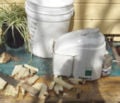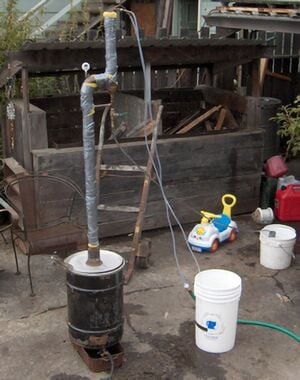
The purpose of my project is to determine the cost inputs and energy outputs of small scale ethanol production from local and conventional sources. I decided to use local grown organic sugar beets farmed with bio-fueled agricultural equipment. In comparison to the costs of a local source, I also used conventional sugar transported from Mexico and sold at a local restaurant supply company. In addition, I made Amal's ethanol still to do the testing.
Ethanol is a grain alcohol that can be used as fuel in most four cycle spark ignition engines. The process of making ethanol begins by extracting the sugars from a sugar crop such as sugar beets, or converting the starches of crops such as corn or potatoes to sugars. Crops used for ethanol production are titled "feed stocks". Starch and sugar crops both have their benefits depending on the region that they are produced in. The benefit of sugar crops is that they require less energy input since no starches need to be converted. The benefit of corn is that it can store much longer than sugar beets before rotting. I am using sugar beets since they were the most appropriate crop for the season and region. The sugars are extracted by juicing the beets and boiling with water. Now the solution is called "mash" and it can be fermented and then distilled to extract the ethanol. Ethanol fuel can be used in most converted engines if it has a alcohol percentage greater than 80%. Due to ethanols strong ability to bind with water, no still can remove the last 5% of water. Therefore the highest possible yield from a still is 95% ethanol. If blending ethanol with gasoline, all the water must removed to prevent separation of the gasoline and ethanol.
Process of Making Ethanol From Sugar Beets[edit | edit source]
Juicing Beets[edit | edit source]
I began by washing the beets and then slicing them up so they would fit in the juicer. I juiced 18lbs of beets which yielded 1.4gal of juice and 7.5lbs of pulp. I then added 2gal of water and mixed juice and pulp together for a total volume of 5gal.
-
Five gallon bucket with 2 gallons of sugar beet juice.
-
The Juicer (beet killa!!).
-
Pulp from juicing the sugar beets.
Fermenting Beets[edit | edit source]
Heated mash to 189F and held temp for 20min to kill bacteria. Total heating process took 45min. I let the mash cool to 80F and then added 100g of Turbo Yeast that was purchased online. Turbo yeast is a special strain of yeast that is claimed to produce up to 14%alc in 48hrs. When fermenting mash it is important to achieve the highest alc% possible so more alc can be collected once distilled. Once yeast was added I agitated the solution for 20min to increase yeast activation then placed on lid and air lock. I let the mash ferment for 72hrs hoping to get all sugars converted to alcohol. I was unable to determine the final alc% of my mash because the solution was too thick for an accurate hydrometer reading.
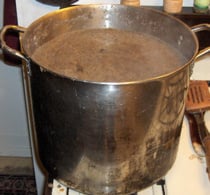
Distilling Beet Mash[edit | edit source]
The pulp which floated to the top of the fermented mash was scraped off, then the rest of the mash was transfered to the boiler of the still. The distillation began with an initial still temperature of 20.7C. After 83min of heating on a propane burner the still temperature reached 78C. Distillate began flowing out of the still and was collected at the rate of.18Liters/min. As time went on, the temperature of the still increased as alcohol was extracted from the boiler. An increase in temperature above 78.5C means more water percentage in the distillate that is being collected, and thus less overall alc% of distillate being collected. To lower the still temperature, the amount of distillate being sent back to the main column from the return line was increased by further closing the reflux valve. As the reflux valve is closed, the amount of reflux increases. The amount of reflux is determined by how much distillate is sent back to the column through the return line per amount that would flow when the reflux valve 100% is open. When more reflux is induced (more percent of distillate is sent back to the column to be re-distilled), the returned liquid drips on the top of the stainless steel scrubber pads (used as packing) and drips down, creating a temperature gradient from top to bottom. As ethanol and water vapor rise up the column from the boiler, the vapor encounters scrubber pads that cool in temperature from bottom to top. The digital thermometer used for determining still temperature is placed above the top of the stacked scrubber pads to read the temperature of the vapors passing through the scrubber pads and on to the condenser. Thus temperatures closest to 78.5C will give the highest percentage of ethanol since 78.5C is the vapor point of ethanol. As the temperature of the still increases, so does the amount of water in the vapor as it rises towards 100C (the vapor point of water). Increasing the amount of reflux drops the temperature of the still, which in turn produces a higher percent ethanol. However, when you increase the ammount of reflux, it reduces the amount of distillate being collected per minute and requires longer operation of the distillation process.

Results and Efficiencies[edit | edit source]
Total amount of distillate collected was 22oz of 80%alc. This amount became 18oz of 100% ethanol once dehydrated. Sugar beets have a sugar content around 20%, so the theoretical yield of ethanol produced is around 50%alc per weight of sugar. So one 1lb of beets with.2lb sugar should yield.1lb of ethanol. Ethanol weighs 6.5lbs/gal. So theoretically 65lb of sugar beets would yield 1gal of ethanol.
My results were that 18lbs of sugar beets yielded 18oz of ethanol. At this rate of yield it would take 128lbs to make one gallon of ethanol. My process was 50.8% efficient when compared to theoretical max yield.
- 12gal of propane were consumed to yield.14gal of ethanol. The Btu input of propane consumed was 194,192Btu to yield 10,598Btu worth of ethanol. The efficiency of ethanol produced in distillation per unit of propane used is 5.5%.
Process of Making Ethanol From Conventional Sugar[edit | edit source]
Making the Sugar Wash[edit | edit source]
The sugar mash began by boiling 4gal of water which took 62min. 25lb of conventional table sugar was added to the boiling water and the pH was lowered to 4.0. More water was added to make a final volume of 12gal. The hydrometer reading showed a Specific Gravity of 1.095 which correlates to 24% sugar and 13%alc potential. 150g of Turbo Yeast was mixed in and the wash fermented for 5 days.
Fermenting Results of Sugar Wash[edit | edit source]
After five days of fermenting, a final hydrometer reading showed that there was 1.5%alc potential left in the fermenter and that the wash was 12 gallons of 11.5%alc. 11.5% of 12gal is a theoretical maximum of 1.38gal of 100% alcohol to be distilled.
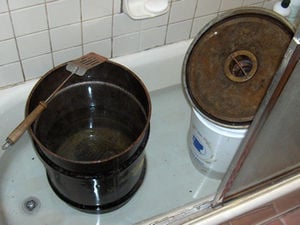
Distilling the Sugar Wash[edit | edit source]
Only 10 gallons of mash was able to fit in the still so the theoretical maximum of alcohol to be distilled lowered to 1.08gal of 100% ethanol. The still was ran for 5hrs on a propane burner and distillate was collected in three categories from start to finish (heads, mids, and tails). The heads were the first 32oz of ethanol collected which had a specific gravity of.8720 and 78%alc. The next group (mids) were collected as one gallon of 81%alc with a specific gravity of.8655. The tails were the the last 32oz collected with 54%alc and a specific gravity of.9250.
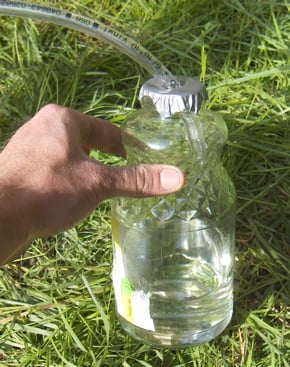
Results and Efficiencies[edit | edit source]
Total amount collected was 144.64oz (1.13gal) of 100% ethanol. My results compared to theoretical maximum yield (1.38gal 100% ethanol) are 81.9% efficient. The 5hr distillation process consumed 2.65gal of propane. 2.65gal propane multiplied by 91,600btu/gal propane is total propane Btu input of 242,740btu to make 1.13gal of ethanol. 1.13gal ethanol multiplied by 75,700btu/gal of ethanol is 98,410btu of ethanol produced.
Therefore it took 242,740btu of propane to yield 98,410btu of ethanol. The efficiency of ethanol produced in distillation per unit of propane used is 40.5%.
Cost per Gallon of Ethanol[edit | edit source]
Cost of Ethanol From Local Organic Beets[edit | edit source]
My results show that distilling with propane consumes more energy than energy stored in the ethanol produced. From this experiment, making.14gal of ethanol required 18lb of sugar beets purchased for $1.00/lb ($18.00). The mash was heated on two natural gas burners for 45min. The amount of energy used in this process is undetermined and will not be included. 100g of Turbo Yeast used cost ($4.16). The distillation process consumed 2.12gal of propane purchased for $3.00/gal ($6.36). Total cost of producing.14gal ethanol was $28.52. Therefore the cost of making ethanol from local organic sugar beets is $203.71/gal.
Cost of Ethanol Produced From Conventional Sugar[edit | edit source]
From this experiment, making 1.13gallons of ethanol required 21lb of conventional sugar purchased for $0.44/lb ($9.24). Also the wash was heated on two natural gas burners for 62min. The amount of energy consumed in this process is undetermined and will not be included in the cost of production. 150g of Turbo Yeast were used ($6.23). The distillation process consumed 2.65gal of propane purchased for $7.95. The total cost of making 1.13gal of ethanol from conventional sugar is $23.42, therefore, making one gallon of ethanol from conventional store-bought sugar costs $20.73.
Conclusion[edit | edit source]
The amount of energy put into local sugar beet ethanol and conventional sugar ethanol is greater than the return. The yields for the local sugar beets were much lower than expected, and many factors could have been at stake. Mixing the beet juice with the pulp may have hindered the yeasts ability to move around mash and ferment all of the sugars available. Also the sugar beets used had been stored for a few months which means their amount of sugars may have degraded. Another possible factor is that the pH was not adjusted before fermentation.
The conventional sugar had much better results than the local sugar beets, however there are many other external costs since the sugar used is a conventionally modified organism grown with the use pesticides and petrol fertilizers. One must question the energy inputs of growing such a crop, processing the harvest, refining the sugar, packaging, and shipping to Northern California from Mexico. All of these factors couldn't be measured in my project but they must be taken into account for their appropriateness.
This project began as an experiment to make fuel for a scooter. After analyzing the energy inputs of small scale ethanol production it doesn't make sense to make backyard ethanol fuel via the use of refined fuels such as natural gas and propane. In the time it took to make enough ethanol to power the scooter 100 miles, I could have ridden my bicycle the equivalent distance. Ethanol fuel is only efficient when crops are grown on a mass scale. The processing facility for making ethanol must be local to the the crop to cut transportation costs. The process of mashing and distilling must rely on non-fossil fueled resources. Heating alternatives are burning of bio-mass or the possible use of solar stills that concentrate the energy of the sun.
Project Costs[edit | edit source]
Ingredients/Materials Costs[edit | edit source]
| Material | Cost |
|---|---|
| 40lb Sugar Beets | $40 |
| 25lb Sugar | $11 |
| 12lb zeolite molecular sieve | $70 |
| 12oz Turbo Yeast | $14 |
| propane burner | $48 |
| 5gal propane tank | $24 |
| Total | $207 |
Time[edit | edit source]
| Phase | Time in hours |
|---|---|
| building still and gathering materials | 40 |
| juicing beets | 7 |
| mashing | 8 |
| distilling | 9 |
| editing | 12 |
| Total | 74 hours |

